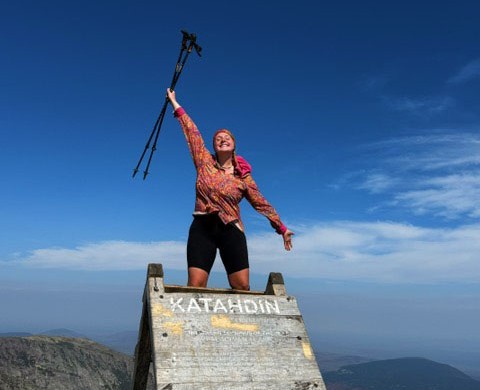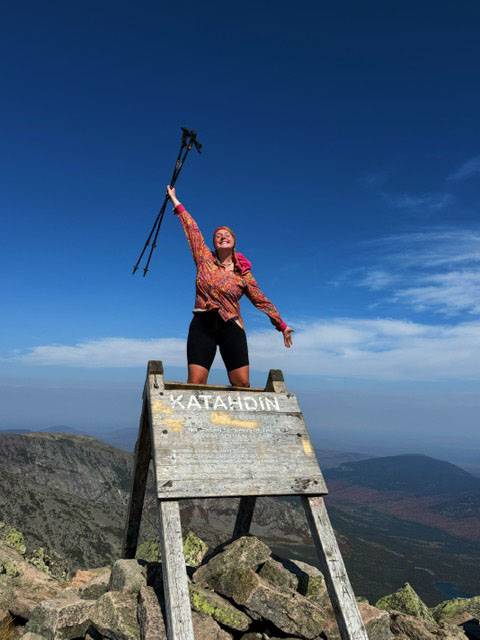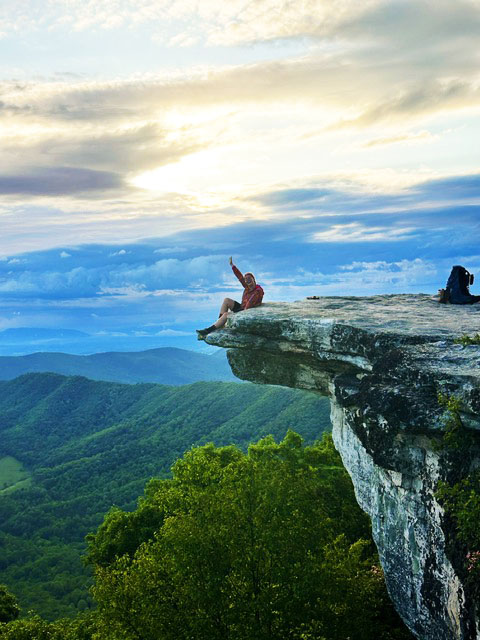
Aroostook woman completes dream of thru-hiking the Appalachian Trail
By Kathleen Phalen Tomasselli, The County Staff
Six months, 14 states and five pairs of shoes after she set off from Springer Mountain, Georgia, a Houlton woman completed the 2,200 mile Appalachian Trail thru-hike to Katahdin earlier this month.
Haven Rhoda, 28, made it to her family’s Houlton home exactly six months after setting out as a solo hiker on April 5 at Amicalola Falls in Dawson County, Georgia. From there, an 8-mile trail led her to the official AT start at Springer Mountain.
While thousands set out to complete the trail like Rhoda, few have what it takes to keep going through the sometimes intense heat, rough terrain, rain, wind and the rigorous daily regimen of 20 or so miles every day. And about 75 percent fail each year, according to the Appalachian Trail Conservancy.
This year’s drought was Rhoda’s biggest concern on the trail because finding water along the 2,200 mile trek north was sometimes difficult. Although she almost got run over by a deer in Pennsylvania, she said, laughing.
Before hiking the trail, the Houlton High School graduate was living and working in Boston for World Hope International, an humanitarian aid organization. But to complete the trail, she left her apartment and quit her job to tackle the AT. She is now living in Houlton with family until she figures out the next dream to conquer.

APPALACHIAN TRAIL THRU HIKER — Houlton resident Haven Rhoda recently completed the Appalachian Trail thru-hike, concluding at the summit of Katahdin.
“My plan is to hike the Pacific Crest trail in 2027,” she said. “That would give me time to save up money and see my family. “
Rhoda first hiked Katahdin with her father when she was 15, and she learned about the AT when meeting thru-hikers that day. From that moment, she knew that’s what she wanted to do.
“It turned into that light at the end of the tunnel goal for myself,” she said, admitting that she was not ever an athletic person and had no experience backpacking. “When I was 18 I said that my goal was to thru-hike before I was 30.”
To build her confidence she began hiking trails from a list of 4,000-foot New Hampshire mountains. Still, those were day trips, and before setting out in April at Springer Mountain, Rhoda had only backpacked overnight once.
Rhoda met thru-hikers on those day hikes who helped her go over her gear list, know what to buy and encouraged her to just go for it.
“It was really a live and learn moment for me,” she said.

MCAFEE KNOB — Houlton resident Haven Rhoda completed the Appalachian Trail thru-hike at Katahdin earlier in the month. Here she is on McAfee Knob in Catawba, Virginia.
Packing for the trip was a bit of a science, since every item adds weight to the pack. Rhoda ended up with one set of clothes, one change of clothes that she slept in, some layers including a fleece and warmer jacket, rain gear, toothpaste, toothbrush, soap, tent, sleeping bag and pad and food for four days.
One day’s worth of food weighs about two pounds, and so she only carried about four or five days of food at a time, stopping at trail towns along the way to replenish supplies, she said. The only exception was when she got to Maine and the 100-mile section of wilderness.
“I carried about five days of food and there is a hiker hostel in that area that comes and will bring you food for that last stretch of time so you don’t have to carry 10 to 12 days of food,” she said.
The easiest foods for Rhoda included lots of high fiber, high carb snacks like instant breakfast packets, fig bars, granola bars for energy because it was almost impossible to eat as much as she was burning, she said.
According to experts, hiking with a heavy backpack burns about 500 to 700 calories an hour, meaning she might burn 6,000 or so calories a day.
“Every night for dinner I made ramen and added chicken packets,” Rhoda said. “It was something I always wanted to eat and it was cheap compared to some of the backpacking meal alternatives.”
Hiking the trail costs about $1,000 to $1,500 a month with food, laundry, gear, hostels, she said.
Water was her drink of choice and she filtered her own so she only had to carry about two liters at a time. And the trail map Rhoda used let her know where water sources were along the way, although some were dried up because of the drought.
There were days where she would have water in the morning but wouldn’t come across water again until the very end of the day.
“I would ration my water. Sometimes the temperature would be 100-plus and that was kind of scary,” she said, adding that she was often saved by what they call trail angels, people who bring supplies to the thru-hikers. “They would leave caches of water, which was absolutely amazing. I’d be running out of water and I would stumble upon jugs of water randomly.”
The journey north started solo, but she met a lot of friends along the way and ended up hiking consistently with a group of five.
Once she got her trail legs, a typical day might start at 6 a.m. and end 25 miles later. But by the time they hit Maine, while mentally wanting to go forever, Rhoda said their bodies were starting to physically hurt.
“I felt like physically I hit my peak in New Hampshire. I was still feeling really strong. But southern Maine was definitely the most difficult section of the trail for me and I could feel myself slowing down, which was frustrating,” she said. “I had to slow down. I was experiencing quite a bit of knee pain and I was exhausted.”
Rhoda said that hiking the AT was a dream that people wouldn’t have expected her to have. Now that it’s over, she wants to spend time meeting other individuals on these trails.
“If someone has a crazy dream, go for it. I never thought this would be what I would do and it just kind of got under my skin and I knew I needed to do it,” Rhoda said. “Even if a dream seems like it doesn’t make sense, don’t count yourself out.”